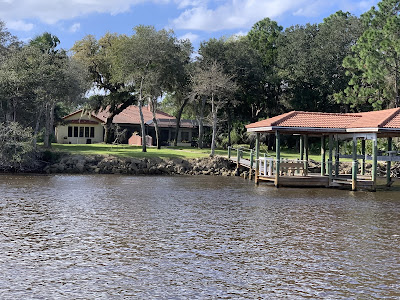Sunday, November 15, 2020
In all fairness, there’s a lot more to St. Augustine than just the touristy areas (and don't forget the beach!). It was wonderful walking around the mostly-deserted streets on a sleepy Sunday morning. Once off the major thoroughfares we finally found restored homes from the early Colonial era that had not been turned into restaurants or stores.
The house above is made of coquina (under a layer of painted stucco), a porous type of limestone made up of tiny shell fragments. It is incredibly strong and resilient, which explains how the Castillo de San Marcos and other structures have survived for over 300 years.
Never one to pass up an outdoor brunch, we tried Schmagel’s Bagels.
We wandered around the Lincolnville Historic District where Martin Luther King had preached and led a march in 1964, prompted by numerous instances of Ku Klux Klan night riders terrorizing that neighborhood. There’s not as much publicity for this historic area but the story of its residents’ relentless fight for integration and civil rights in the face of daunting and violent opposition is testimony to their incredible courage and determination.
We also walked around the campus of Flagler College. It would be difficult to overemphasize the role of industrialist Henry Flagler in the development of Florida’s east coast. One of the founders of Standard Oil, he and his family visited Jacksonville, Florida, for the winter of 1878 on the advice of his wife’s physician, hoping (unsuccessfully) that the warm and sunny weather would alleviate her health concerns. But, like the Bensons, he was hooked.
Flagler returned to Florida with his second wife and in 1885 began his decades-long construction of the hotel and railway empire that would entice northerners to come to Florida—and provide the transportation to get there. He used convict leasing to modernize the existing short line railroads which he bought up, consolidated and expanded to form the Florida East Coast Railway. Eventually it would reach all the way to Key West. (We’ll see more of his influence as we travel south.)
Flagler’s first venture in St. Augustine was the 540-room Ponce de Leon Hotel, opened in 1888 and now the welcoming face of Flagler College. Designed in the Spanish Renaissance style, the ubiquitous red roof tiles and stucco walls seen throughout Florida can trace their popularity back to this architectural trendsetter. Louis Comfort Tiffany designed the interior of the hotel (including the spectacular stained glass windows of the dining room) and Flagler’s friend, Thomas Edison, was involved in electrifying the building.
Demand for “something to do” while visiting the “American Riviera,” inspired Flagler to build the 300-room Alcazar Hotel across the street a year later. It offered a casino, salons, steam rooms, Turkish baths, a bowling alley and an indoor swimming pool. It now houses City Hall and the Lightner Museum. It is one of the first buildings in the U.S. constructed of poured concrete.
I’m glad we gave St. Augustine a second chance. We were even treated to a Maxfield Parrish sunset:


















































